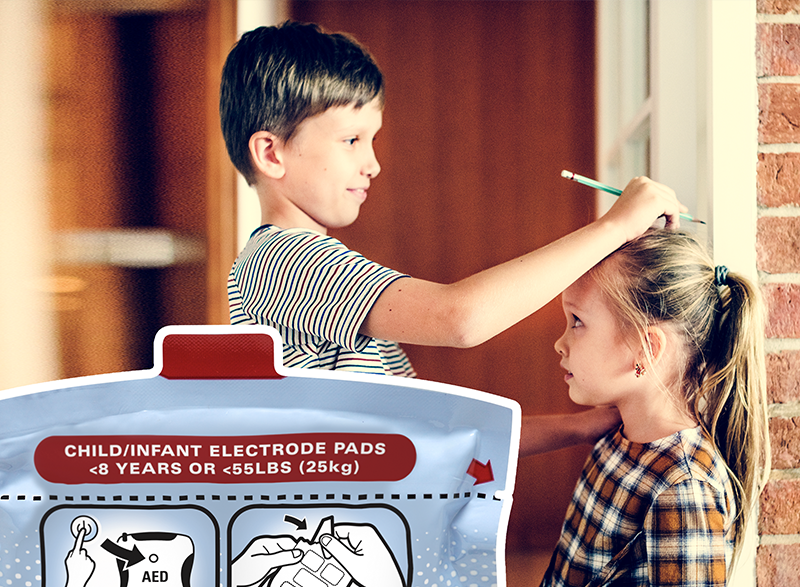How To Use Pediatric AED Pads
May 17, 2022

When someone suffers a
sudden cardiac arrest, it is crucial an
Automated External Defibrillator (AED) is used quickly to help save their life. Statistically, if someone is shocked within one minute of suffering sudden cardiac arrest, they have a 90% chance of survival. Each minute after decreases that person’s chances of survival 10%. This is why it is crucial AEDs are EVERYWHERE!
It is very important to remember you do not need medical training to use an AED. Anyone can use one. Just turn it on and follow the step-by-step instructions. You cannot hurt someone with an AED. It will not deliver a shock to a person that does not need one.
SCA Can Happen To Anyone – Even Children
What about using an AED on a child? Sudden cardiac arrest does not discriminate! It affects people of all ages.
If the sudden cardiac arrest victim is 8 years old or younger and less than 55 pounds, use
pediatric pads. If pediatric pads are not available you can use adult pads. When using adult pads on someone ages one to eight, place one pad in the center of the chest and the other pad in the middle of the back, between the shoulder blades.
It is important to not delay therapy to determine the exact age or weight. The AED needs to be used as quickly as possible to ensure the highest chances of survival.
If a child is unresponsive, unconscious, and not breathing normally, they need an AED. Use the AED is soon as it arrives. The quicker it is used, the higher the chances of survival.
Steps On How To Use Pediatric Pads
Step 1:
Power on the AED. Our
Lifeline AEDs have a very clear, green “on” button. Once you press the button, the machine will start talking to you. It will first tell you to “call for help.” If you have not called 9-1-1 yet, call 9-1-1 immediately.
Step 2:
Next, the AED will tell you to “remove pads from package in back of unit.” Defibtech AEDs make the pads easy to find! Just turn the machine around and you will see the pads pack in the back of the unit.
Step 3:
The AED will now tell you to “apply pads to patient’s bare chest as shown.” It is important that the patient’s chest is completely bare. The pads cannot be placed over any type of clothing. The pads have pictures on them. When you tear open the pads package you will see one picture showing a pad in the center of the child’s chest. The other picture will show a pad being placed on the child’s back, between the shoulder blades. Place the pads firmly as they are shown in the pictures.
Step 4:
Once the pads are placed correctly the machine will say, “analyzing heart rhythm, do not touch the patient.” It is important to make sure no one is touching the patient at this time. Look up and down the body. Loudly state, “Stand clear.” If the machine determines a shock is needed, it will say, “Shock Advised. Charging. Stand Clear.” Again, look up and down the body. Loudly state, “Stand clear.”
Step 5:
Once the machine has finished charging, it will say, “Press flashing shock button.” Defibtech AEDs have a bright shock button found on the front of the unit. Press this button when it is flashing and the AED tells you to.
Step 6:
Once you deliver the first shock, the machine will say, “Shock one delivered. It is safe to touch the patient. Begin CPR now.” You can now provide CPR to the person. NEVER remove the pads. Perform CPR with the pads still on the body. You will hear a metronome that will give you the perfect beat to provide chest compressions. The AED will allow you to provide CPR for two minutes. After two minutes that machine will re-analyze and determine if a second shock is needed. This process will continue until EMS arrives.
Every situation is different. If the AED is used very quickly, one shock might bring the child back to being responsive and breathing. If this happens, you do not need to provide CPR, but you need to monitor the person until EMS arrives. The child might go back into cardiac arrest again, if this happens, start CPR immediately.
Other situations might require multiple rounds of CPR, multiple shocked from the AED, and medication administered by EMS to bring the child back.
Remember, whether an adult of a child is suffering from sudden cardiac arrest, you can use an AED to help save their life!
To learn more about Defibtech and to join us on our quest to save lives from sudden cardiac arrest, visit
www.Defibtech.com.
